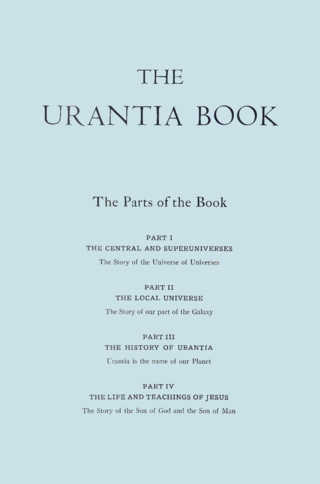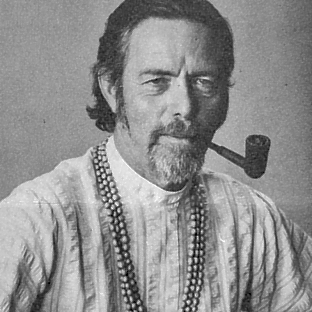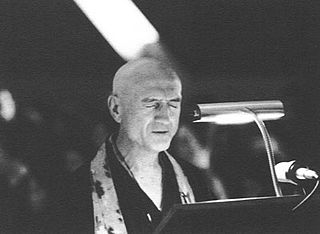Related Research Articles

Unity, known informally as Unity Church, is an organization founded by Charles and Myrtle Fillmore in 1889. It grew out of Transcendentalism and became part of the New Thought movement. Unity is known for its Daily Word devotional publication. Unity describes itself as "for people who might call themselves spiritual but not religious."

Thomas Merton was an American Trappist monk, writer, theologian, mystic, poet, social activist and scholar of comparative religion. On May 26, 1949, he was ordained to the Catholic priesthood and given the name "Father Louis". He was a member of the Abbey of Our Lady of Gethsemani, near Bardstown, Kentucky, living there from 1941 to his death.

The Urantia Book is a spiritual, philosophical, and religious book that originated in Chicago sometime between 1924 and 1955. The authorship remains a matter of debate. It has received various degrees of interest ranging from praise to criticism for its religious and science-related content, its unusual length, and the unusual names and origins of the authors named within the book.

Alan Wilson Watts was an English writer, speaker and self-styled "philosophical entertainer", known for interpreting and popularising Japanese, Chinese and Indian traditions of Buddhist, Taoist, and Hindu philosophy for a Western audience. Born in Chislehurst, England, he moved to the United States in 1938 and began Zen training in New York. He received a master's degree in theology from Seabury-Western Theological Seminary and became an Episcopal priest in 1945. He left the ministry in 1950 and moved to California, where he joined the faculty of the American Academy of Asian Studies.
Buddhism in the West broadly encompasses the knowledge and practice of Buddhism outside of Asia in the Western world. Occasional intersections between Western civilization and the Buddhist world have been occurring for thousands of years. The first Westerners to become Buddhists were Greeks who settled in Bactria and India during the Hellenistic period. They became influential figures during the reigns of the Indo-Greek kings, whose patronage of Buddhism led to the emergence of Greco-Buddhism and Greco-Buddhist art. There was little contact between the Western and Buddhist cultures during most of the Middle Ages but the early modern rise of global trade and mercantilism, improved navigation technology and the European colonization of Asian Buddhist countries led to increased knowledge of Buddhism among Westerners. This increased contact led to various responses from Buddhists and Westerners throughout the modern era. These include religious proselytism, religious polemics and debates, Buddhist modernism, Western convert Buddhists and the rise of Buddhist studies in Western academia. During the 20th century, there was a growth in Western Buddhism due to various factors such as immigration, globalization, the decline of Christianity and increased interest among Westerners. The various schools of Buddhism are now established in all major Western countries making up a small minority in the United States, Europe, Australia and New Zealand.

Self-Realization Fellowship (SRF) is a worldwide, spiritual organization founded by Paramahansa Yogananda in 1920 and legally incorporated in the United States as a non-profit religious organization in 1935. Before coming to the United States, Yogananda began his spiritual work in India in 1917 and named it Yogoda Satsanga Society of India (YSS). He then founded SRF in 1920 which became the international headquarters for the SRF and YSS, located on Mount Washington in Los Angeles, California.
Károly Kerényi was a Hungarian scholar in classical philology and one of the founders of modern studies of Greek mythology.

Geshe Kelsang Gyatso was a Buddhist monk, meditation teacher, scholar, and author. He was the founder and spiritual director of the New Kadampa Tradition-International Kadampa Buddhist Union (NKT-IKBU), a registered non-profit, modern Buddhist organization that came out of the Gelugpa school/lineage. 1,300 centres around the world, including temples, city temples and retreat centres offer an accessible approach to ancient wisdom.

The Religious Science movement, or Science of Mind, was established in 1926 by Ernest Holmes and is a spiritual, philosophical and metaphysical religious movement within the New Thought movement. In general, the term "Science of Mind" applies to the teachings, while the term "Religious Science" applies to the organizations. However, adherents often use the terms interchangeably.

Philip Kapleau was an American teacher of Zen Buddhism in the Sanbo Kyodan tradition, a blending of Japanese Sōtō and Rinzai schools. He also advocated strongly for Buddhist vegetarianism.
The Way of a Pilgrim, or The Pilgrim's Tale, is the English title of a 19th-century Russian work, recounting the narrator's journey as a mendicant pilgrim while practicing the Jesus Prayer. The pilgrim's travels take him through southern and central Ukraine, Russia, and Siberia. It is unknown if the book is literally an account of a single pilgrim, or if it uses a fictional pilgrim's journey as a vehicle to teach the practice of ceaseless inner prayer and communion with God. The Russian original, or a copy of it, was present at a Mount Athos monastery in Greece in the 19th century, and was first published in Kazan in 1884, under the Russian title that translates as "Candid Narratives of a Pilgrim to His Spiritual Father."
Masao Abe was a Japanese Buddhist philosopher and religious studies scholar who was emeritus professor at Nara University. He is best known for his work in comparative religion, developing a Buddhist-Christian interfaith dialogue which later also included Judaism. His mature views were developed within the Kyoto School of philosophy. According to Christopher Ives: "Since the death of D. T. Suzuki in 1966, Masao Abe has served as the main representative of Zen Buddhism in Europe and North America."

Dallas Albert Willard was an American philosopher also known for his writings on Christian spiritual formation. Much of his work in philosophy was related to phenomenology, particularly the work of Edmund Husserl, many of whose writings he translated into English for the first time.
Metapsychiatry is a spiritual teaching and form of psychotherapy developed by psychiatrist Thomas Hora (1914–1995) in the second half of the 20th century. Hora described it as "a scientific method of healing and education based on metaphysical concepts of man and the universe". Metapsychiatry was inspired by Hora's dissatisfaction with what he believed was psychoanalysis's failure to account for human spirituality, and his observation that psychiatric healing was often temporary. It is characterized by a hermeneutic approach.

Béla Hamvas was a Hungarian writer, philosopher, and social critic. He was the first thinker to introduce the Traditionalist School of René Guénon to Hungary.
Progressive revelation is a core teaching in the Baháʼí Faith that suggests that religious truth is revealed by God progressively and cyclically over time through a series of divine Messengers, and that the teachings are tailored to suit the needs of the time and place of their appearance. Thus, the Baháʼí teachings recognize the divine origin of several world religions as different stages in the history of one religion, while believing that the revelation of Baháʼu'lláh is the most recent, and therefore the most relevant to modern society.

Claude Anshin Thomas is an American Zen Buddhist monk and Vietnam War veteran. He is an international speaker, teacher and writer, and an advocate of non-violence. Thomas was brought to Buddhism by Vietnamese Zen Buddhist teacher Thich Nhat Hanh, and was ordained in 1995 by Tetsugen Bernard Glassman of the Zen Peacemaker Order. Thomas teaches Buddhist meditation practice and dharma to the public through social projects, talks, and retreats. Since 1994, Thomas has walked 19,000 miles (31,000 km) on peace pilgrimages throughout Europe, Asia, the Middle East, and the United States. While walking, Thomas carries no money, and begs for food and shelter in the mendicant monk tradition. He is the author of At Hell's Gate: A Soldier's Journey from War to Peace (2004) and founder of the Zaltho Foundation, a nonprofit organization dedicated to ending violence.
The Baháʼí Faith in Hungary started in various mentions of the religion in the 19th century followed by ʻAbdu'l-Bahá's trip to Hungary in 1913 when Hungary's first Baháʼí joined the religion. The community suffered from World War II and communist rule until the 1980s. The National Assembly was elected in 1992 and in 2002 Baháʼí sources claimed 1100 and 1200 Baháʼís in Hungary, many of which are Roma. In 2010 the Association of Religion Data Archives estimated 290 Baháʼís in Hungary.

Rami M. Shapiro, commonly called "Rabbi Rami", is an author, teacher, and speakeron the subjects of liberal Judaism and contemporary spirituality.
Buddhism in Hungary has existed since 1951 when Ernő Hetényi founded the Buddhist Mission in Germany, as a member of the Arya Maitreya Mandala Buddhist order. However, the first Buddhist community had been founded in the 1890s in Máramarossziget. József Hollósy took refuge and wrote Buddhista Kátét (1893) — the first Buddhist catechism in Hungarian. According to this, the Dharma has been present in Hungary for more than a century. In 1933 the Hungarian philologist and Orientalist — author of the first Tibetan-English dictionary and grammar book Sándor Kőrösi Csoma — was recognised as a bodhisattva in Japan. In Hungary József Hollósy is regarded as the second bodhisattva.